Land Invertebrates
Media
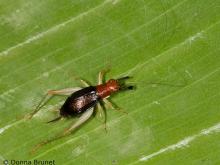
Species Types
Scientific Name
Phyllopalpus pulchellus
Description
The handsome trig lives in vegetation about four feet off the ground near water. This beetle-like cricket may be a mimic of bombardier beetles, which spew foul chemicals for defense.
Media

Species Types
Scientific Name
8 tribes, with about 23 genera, in North America north of Mexico
Description
Millipedes in family Xystodesmidae often have bright colors that serve as a warning to potential predators that they may secrete foul or toxic substances.
Media

Species Types
Scientific Name
Araneus marmoreus
Description
The marbled orbweaver is sometimes called the “pumpkin spider” because its rounded abdomen is sometimes bright orange. The color and markings can vary greatly.
Media
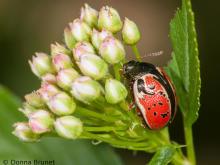
Species Types
Scientific Name
Calligrapha spiraea
Description
The ninebark calligraphy beetle is one of nearly 40 North American calligraphy beetles, named for the scrawly markings on their backs. Most calligraphy beetles require particular host plants.
Media
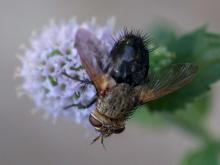
Species Types
Scientific Name
About 1,350 species in North America north of Mexico
Description
Tachinid flies are one of the largest families of flies. They are parasitic flies whose larvae are parasitoids of other insects. They look a lot like house flies, blow or bottle flies, wasps, or bees. Many are very bristly.
Media

Species Types
Scientific Name
About 2,000 species in North America north of Mexico
Description
Plant bugs, or mirids, are a huge family of true bugs. They are often overlooked — except by gardeners and farmers. Most mirids eat plants, and some are agricultural pests. As a group, they’re an important food source for birds and other insectivores.
Media
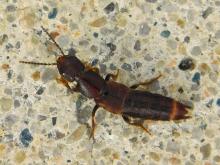
Species Types
Scientific Name
More than 4,400 species in North America north of Mexico
Description
Rove beetles usually have very short wing covers, so several of their hind abdominal segments are exposed. Typically fast movers, they often flip up their abdomen tips when frightened. This is a huge family of beetles.
Media
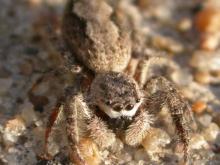
Species Types
Scientific Name
Platycriptus undatus
Description
The tan jumping spider usually lives on tree trunks. Its gray, tan, and brown coloration camouflages it against tree bark. There is usually an undulating pattern on the abdomen.
Media

Species Types
Scientific Name
About 1,700 species in North America north of Mexico
Description
The scarab beetle family is very large, with breathtaking variety — and often great beauty. Many scarabs are large and colorful.
See Also



Media

Species Types
Scientific Name
Cisseps fulvicollis
Description
The yellow-collared scape moth is more often “orange-collared.” And whether you think it looks more like a firefly or a wasp, it’s still a moth!
Media

Species Types
Scientific Name
Nearly 150 species in North America north of Mexico
Description
Slim, delicate plume moths are instantly recognizable by their T-shaped silhouette, long legs, and muted shades of tan and brown. It can be hard to separate the various species.
Media

Species Types
Scientific Name
Pyrrharctia isabella
Description
Not many people know the adult Isabella tiger moth when they see one, but we’re all acquainted with its caterpillar, the woolly worm, or woolly bear.
About Land Invertebrates in Missouri
Invertebrates are animals without backbones, including earthworms, slugs, snails, and arthropods. Arthropods—invertebrates with “jointed legs” — are a group of invertebrates that includes crayfish, shrimp, millipedes, centipedes, mites, spiders, and insects. There may be as many as 10 million species of insects alive on earth today, and they probably constitute more than 90 percent all animal species.





















